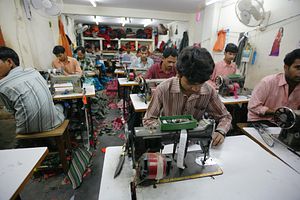A lot has been said in the past decade about the ascent of emerging economies (EME) in the global South. Their sustained growth and attractiveness as a destination for investment has drawn much academic and policy attention. India, as part of BRICS (the trailblazing manifestation of the EME phenomenon), and also as the largest democracy, has been at the center of much of the praise lavished on these EMEs. A lot of the optimism surrounding India owed to its bulging young population, poised to rise to 64 percent of the country’s total population by 2020, a stark contrast to greying EU and Japan.
However, there is a gloomier side to this perceived demographic dividend, one that could trump all sense of cheer: the prospect of increasingly unmanageable unemployment in a country forecast to have almost 1.7 billion people by 2050. At present, 12 million people enter the Indian workforce each year. A substantial share of them are low skilled workers, many having migrated from rural India to the urban centers. Jobs are not being created at a concomitant pace. Meanwhile, 40 percent of India’s population are expected to be living in cities by 2030.
Thanks to a slowdown in the Indian economy in the last year or so, investments have stalled and the government has cut back on capital expenditure to ensure fiscal prudence. An economic contraction and resulting stagnation or loss of jobs now looks inevitable.
India’s unique positioning in the global marketplace as a services-led economy is in contrast to most other developing economies, including China, which took the traditional route of labor-intensive manufacturing followed up by higher value added part-labor, part-capital intensive manufacturing. This has come back to haunt India. While the services sector – employing decently skilled English-speaking workers – has had its share of glory, it cannot provide employment to the teeming masses. The scale and nature of employment that is required to employ people with limited skills and education can only be provided by mid- and low-end manufacturing.
After India liberalized in 1991, the services sector was long the fastest growing part of the economy, contributing significantly to GDP, economic growth, international trade and investment. Manufacturing contributes just 16 percent to India’s GDP, compared to a 56.5 percent contribution by services. According to the Reserve Bank of India (RBI), India’s ITeS/BPO exports rose 37 percent in 2012-13. While manufacturing exports continue to perform well, most of it remains in the skill-intensive sector (automotive, engineering, etc.). This does nothing for the large swathe of low-skilled workers who are either unemployed or laboring away in hazardous, inhumane conditions beyond the purview of established formal state regulations. Moreover, manufactured goods as a share of total Indian exports pales in comparison to the level in China.
The policymaking focus has now finally shifted to the manufacturing sector, with the government instituting a National Manufacturing Policy in 2011. The policy laid out plans to boost the manufacturing sector by raising its contribution to GDP to 25 percent and creating 100 million new jobs by 2025.
Even today, India’s share of global manufacturing stands at little over 2 percent. China has meanwhile over the years positioned itself as the workshop of the world, accounting for 22.4 percent of global manufacturing. For India to achieve its stated goals of reviving the manufacturing sector and providing jobs to the tens of millions of unemployed youth, IT will need massive investment, including major contributions from foreign investors. What will be particularly helpful to India’s job creation needs is vertical foreign direct investment (FDI), wherein production in the host economy is intended not just to serve the local (host) economy but also global exports. Such FDI is more employment intensive and also responds positively to quality infrastructure. This would also ensure that India is seen as more than just a consumer economy, where the primary category of FDI is horizontal or market-seeking.
Staying with the concerns of the workforce, reforming existing labor laws, while politically difficult, will eventually be in the interests of the populace. In non-agricultural urban India, where almost 70 percent of those employed fall beyond the “registered” manufacturing sector (i.e., the informal economy), there is an urgent need to not only formalize these professions but also encourage long-term, big ticket investments in large-scale manufacturing in order to provide meaningful employment to low-skilled workers. If India wants to avoid unemployment-spurred social mayhem, this is the approach to take.
The most urgent need is to upgrade India’s physical infrastructure to encourage domestic and foreign direct investment in the manufacturing sector. This will absorb the rural labor surplus that is migrating to the cities by providing employment in labor-intensive, less technology-intensive manufacturing, regulated by humane labor laws catering to the contemporary needs of the economy.
Abhirup Bhunia is a researcher at the Observer Research Foundation, New Delhi.

































